
Why We Sleep:
Unlocking the Power of Sleep and Dreams
On this page:
- ⭐ Key Notes: 12 tips for healthy sleep
- 😴 Chapter 1: to sleep…
- ☕ Chapter 2: caffeine, jet lag, and melatonin
- 👁 Chapter 3: defining and generating sleep
- 🦍 Chapter 4: ape beds, dinosaurs, and napping with half a brain
- 👶🏻 Chapter 5: changes in sleep across the life span
- 🎓 Chapter 6: your mother and Shakespeare knew
- 🚗 Chapter 7: too extreme for the Guinness Book of World Records
- 🦠 Chapter 8: cancer, heart attacks, and a shorter life
- 🥼 Chapter 9: routinely psychotic
- 🔮 Chapter 10: dreaming as overnight therapy
- 💭 Chapter 11: dream creativity and dream control
- 😰 Chapter 12: things that go bump in the night
- ⏰ Chapter 13: iPads, factory whistles, and nightcaps – what is stopping you from sleeping?
- 💊 Chapter 14: hurting and helping your sleep
- 📉 Chapter 15: what medicine and education are doing wrong; what Google and NASA are doing right
- 🎁 Chapter 16: a new vision for sleep in the twenty-first century
- 📹 Video Summary
⭐ Key Notes: 12 tips for healthy sleep
- Stick to a sleep schedule.
- Exercise for at least 30 minutes each day, but not later than 2 hours before bedtime.
- Avoid caffeine and nicotine.
- Avoid alcohol before bed.
- Avoid large meals and beverages late at night.
- Avoid medicines that delay or disrupt sleep.
- Do not take naps after 3pm.
- Relax before bed – add reading or music to your bedtime ritual.
- Take a hot bath before bed.
- Bedroom environment – dark, cool, and gadget-free.
- Have the right sunlight exposureoe – get 30 minutes of natural sunlight each day. Wakeup with the sun, or use very bright lights in the morning.
- Do not lie in bed awake.
Part 1: This Thing Called Sleep
😴 Chapter 1: to sleep…
- The shorter you sleep, the shorter your life span.
- Sleep is the single most effective thing we can do to reset the health of our brain and body.
- Humans are the only species that will deliberately deprive themselves of sleep, without any legitimate gain.
☕ Chapter 2: caffeine, jet lag, and melatonin
Factors that determine when we want to sleep
- Suprachiasmatic nucleus – an internal 24-hour body clock located within your brain [wake drive].
- Adenosine – a chemical that builds up in your brain to create sleep pressure [sleep drive]
- The urge to be awake is greatest in the morning, when the gap between the wake drive and sleep drive are small.
- The urge to sleep is greatest at night, when the gap between the wake drive and sleep drive are largest.
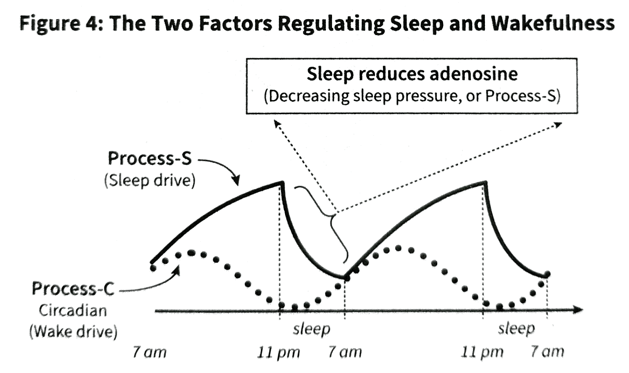
Melatonin
- Mealtonin helps regulate the timing of when sleep occurs, by signalling darkness throughout your body.
- Melatonin has little influence on the generation of sleep itslef – it is not a powerful sleeping aid in itself.
- The suprachiasmatic nucleaus instructs the release of melatonin into the bloodstream after dusk.
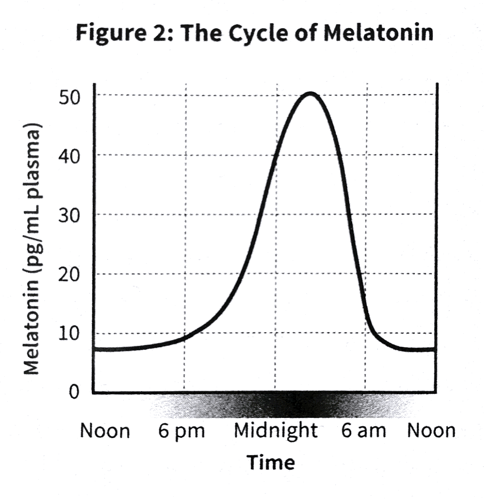
Sleep pressure and caffeine
- Adenosine is a chemical that builds up in your brain throughout the day – it increases your desire to sleep.
- Caffeine works by battling with adenosine for the priviledge of latching onto adenosine receptors in the brain.
- By hijacking these receptors, caffeien blocks the sleepiness signal that is normally communicated to the brain by adenosine.
- Some people process caffeine faster than others, and we become less efficient as we age.
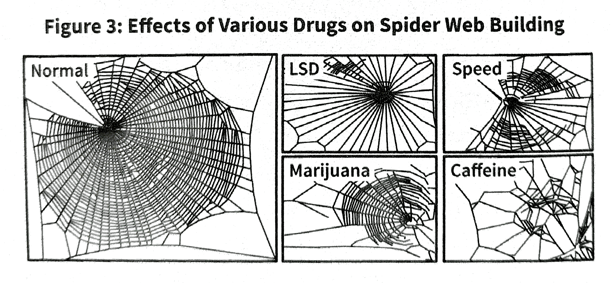
Circadian rhythm
- All living organisms have a neural circadian rhythm to keep time.
- The circadian rhytm is not dependent on external cues, such as sunlight.
- The human circadian rhythm is slightly longer than 24 hours.

Identify sleep deficiency
- If you did not set an alarm clock, would you wake up on time?
- Do you find yourself re-reading things?
- Can you function optimally before noon without caffeine?
- Could you fall back asleep at 10-11am?
👁 Chapter 3: defining and generating sleep
- The thalamus is the sensory gate of the brain. It puts a perceptual barricade to block incoming sensory signals while you sleep.
- Sleeping organisms – adopt a stereotypical position, have lowered muscle tone, and show no over displays of responsivity.
- The subconscious brain is capable of logging time.
Two types of sleep
- NREM – non-rapid eye movement.
- 4 stages of increasing depth.
- removes unneccessary neural connections.
- REM – rapid eye movement.
- Brain activity is almost identical to awake state.
- Associated with dreaming.
- Strengthens neural connections.
Sleep cycle
- REM and NREM stages play out a recurring battle for domination across 90 minute intervals.
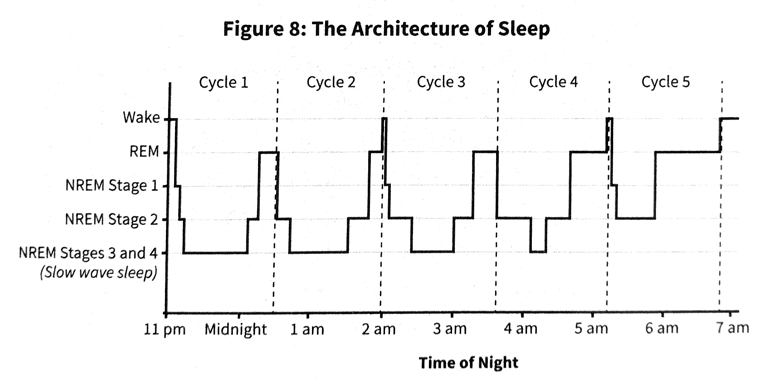
Generating sleep
- Wakefulness = reception
- NREM sleep = reflection
- REM sleep = integration
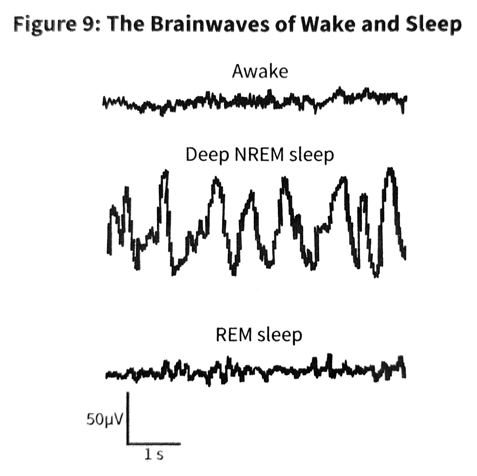
🦍 Chapter 4: ape beds, dinosaurs, and napping with half a brain
- Not all species experience all stages of sleep.
- All have measurable NREM sleep stages.
- Most reptiles, amphibians, fish, and insects show no clear signs of REM sleep.
- Cetaceans and brids sleep with half a brain at a time – it only applied to NREM sleep.
- Starvation will cause the need for food to supersede the need for sleep.
How should we sleep?
- Hunter-gatherer tribes sleep in a biphasic pattern. They take a longer sleep period at night (7-8 hours), followed by a 30-60 minute nap in the afternoon.
- They go to sleep 2-3 hours after sunset (around 9pm).
- Midnight is supposed to be the middle of the sleep cycle.
- Humans have a hardwired dip in alertness that occurs mid-afternoon.
👶🏻 Chapter 5: changes in sleep across the life span
Childhood
- Infants display polyhasic sleep – many short snippets of sleep throughout day and night.
- The csprachiasmatic nucleus, which controls our circadian rhythm, takes a considerable time to develop.
Adolescence
- During puberty – NREM sleep increases to promote efficiency and effectiveness.
- Deep sleep may be a driving force of brain maturation.
- The circadian rhythm shifts forward – making teenagers want to stay up longer.
- Asking a teenager to go to sleep at 10pm is equivalent of asking an adult to sleep at 7pm.
Midlife and old age
- Older adults need as much sleep, but are less able to generate it.
- NREM sleep is in decline by the late twenties.
- Sleep fragmentation – the older we get, the more frequently wake up throughout the night (most commondly due to weakened bladder).
- Lower sleep efficiency leads to higher mortality risk, worse physical health, less energy, and lower cognitive function.
Part 2: Why Should You Sleep?
🎓 Chapter 6: your mother and Shakespeare knew
- Sleep restores the brain’s capacity for learning – to prepare the bran for making new memories and cementing previous memories.
- Sleep protects newly acquired information against forgetting.
- NREM brainwaves transport memory from the temporary hippocampus to the more permanent cortex.
- Sleep clears the cache of short term memory.
- Sleep discerns what memories to remember and which to forget.
- Lack of sleep decreases time to physical exhaustion and aerobic output.
- Post-performance sleep accelerates physical recovery.
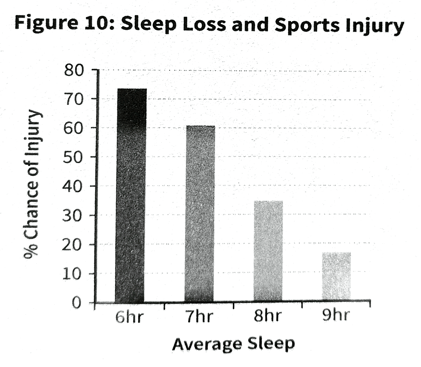
🚗 Chapter 7: too extreme for the Guinness Book of World Records
Concentration
- The brain function that suffers most under sleep deprivation is concentration.
- Sleep deprived people underestimate the degree to which their performance is reduced.
- Humans need more than 7 hours of sleep to maintain cognitive performance.
- Behicle accidents caused by drowsy driving exceeds those caused by alcohol and drugs combined.
- After being awake for 19 hours, sleep-deprived people are as cognitively impaired as those who are legally drunk.
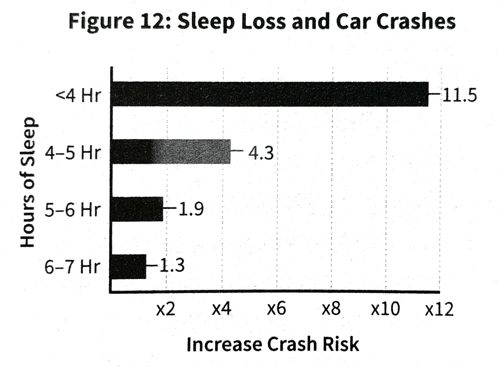
Salvaging sleep deprivation
- Power naps and caffeine may momentarily increase basic concentraiton during sleep deprivaiton.
- The more complex functions cannot be salvaged by naps or caffeine – learning, memory, complex reasoning, decision-making.
Foregtfulness and alzheimer’s
- Students who stay up late cramming for tests experience a 40% deficit in their ability to make new memories relative to those that get a full nights sleep.
- Wakefulness is low-level brain damage, whereas sleep is neurological sanitation.
- Getting too little sleep will increse the risk of developing alzheimer’s disease.
🦠 Chapter 8: cancer, heart attacks, and a shorter life
Impact on the body
- Poor sleep has been observed to increase the risk of heart attack.
- Sleep deprivation also increases the likelihood of infections.
- Unhealthy sleep leads to an unhealthy heart and a weakened immune system.
- Testosterone levels drop relative to a fully rested baseline.
Impact on weight gain
- Less sleep increases the likelihood of eating.
- Chronic sleep deprivation is a major contributor to type 2 diabetes.
- Short sleep causes the body to deplete muscle mass and retain fat.
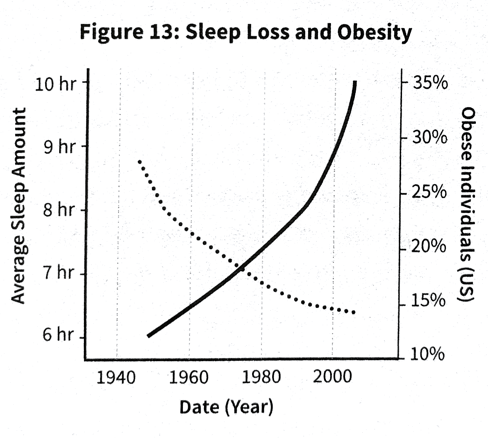
Part 3: How and Why We Dream
🥼 Chapter 9: routinely psychotic
- REM sleep accounts for the hallucinogenic, emotional, and bizzare experiences.
- REM sleep is a state characterised by strong activation in visual, motor, emotional, and autobiographical memory regions of the brain.
- MRI scans can be used to predict the content of your dreams, by matching images of brain activity to baseline templates.
- Daytime emotions have some influence over the emotional themes of our dreams.
🔮 Chapter 10: dreaming as overnight therapy
- REM sleep is the only time when your brain is completely devoid of noradrenaline – an anxiety-triggering molecule.
- Noradrenaline is the brain equivalent of adrenaline.
- REM sleep helps us divorce emotions from experience, by readjusting the brain’s emotional state.
- Dreaming about difficult life events helps people gain clinical resolution from their despair.
💭 Chapter 11: dream creativity and dream control
- Sleep builds connections between distantly related information elements that are not obvious during the waking day.
- Relational memory processing is accelerated during REM sleep.
- Lucid dreaming is possible, whereby the person can control when and what they dream.
Part 4: From Sleeping Pills to Society Transformed
😰 Chapter 12: things that go bump in the night
Somnabulism
- Sleep disorders that involve movement, such as sleepwaking and sleep talking.
Insomnia
- Clinical difficulty falling asleep or staying asleep.
- Often triggered by worry or anxiety.
Narcolepsy
- Excessive daytime sleepiness – sudden and irresisible urges to sleep.
- Sleep paralysis – loss of ability to talk or move when waking up from sleep.
- Cataplexy – sudden loss of muscle control. Caused by body paralysis of REM sleep, without the sleep of the REM state itself.
⏰ Chapter 13: iPads, factory whistles, and nightcaps – what is stopping you from sleeping?
- Electric light
- Alcohol
- Regularised temperature
- Caffeine
- Punching time cards
Artificial light
- Artificial light will fool your suprachiasmatic nucleus into believing that the sun has not yet set.
- Melatonin is not released on schedule.
- Blue LED light has twice the harmful impact on nighttime melatoninsuppression than warm yellow light.
- Maintaining complete darkness throughout the night is also critical.
Alcohol
- Alcohol fragments sleep.
- Non-continuous sleep is not restorative.
- Alcohol is a powerful REM suppressor that deprives dream sleep.
Temperature
- A bedroom temperature of 18,3 Celsius / 65 Fahrenheit is ideal for the sleep of most people.
- Core body temperature must decrease 2-3 degrees Farenheit to initiate sleep.
- Body temperature is controlled by your hands, feet, and head. Warming these areas will draw heat from the innner core.
- Hot baths prior to bed can induce 10-15% more deep NREM sleep.
- Hot baths lowers our core body temperature – ddiluted blood vessels help radiate out inner heat.
Artificial wakeup
- Being artificially woken up by alarm clocks spikes our blood pressure and suddenly accelerates the heart rate.
- The fight or flight nervous system is triggered.
- Snoozing through multiple alarms will repeat this shock over and over again.
💊 Chapter 14: hurting and helping your sleep
Sleeping pills
- Those taking sleeping pills have a higher mortlity rate.
- Sleeping pills are addictive and almost always cause more harm than benefit.
Good sleep practices
- Establish a regular and consistent bedtime and wake-up time.
- Go to be only when sleepy.
- Do not lie awake in bed for a significant peiord of time.
- Avoid daytime napping, if you have difficulty sleeping at night.
- Reduce anxiety-provoking thoughts and worries.
- Remove visible clock faces from view in the bedroom.
📉 Chapter 15: what medicine and education are doing wrong; what Google and NASA are doing right
Business
- The brain can never recover all the sleep it has been deprived of.
- Business leaders often mistake hours for productivity.
- A study across four US companies found that insufficient sleep cost almost $2,000 in lost productivity, per employee per year.
- Insufficiant sleep robs some nations of over 2% of GDP.
- Creativity, intelligence, motiovation, effort, efficiency, collaboration, emotional stability, sociability, and honesty are all impacted by insufficient sleep.
- Sleep deprived individuals generate fewer and less accurate solutions.
- People are more likely to lie, cheat, and steal when sleeping less than six hours.
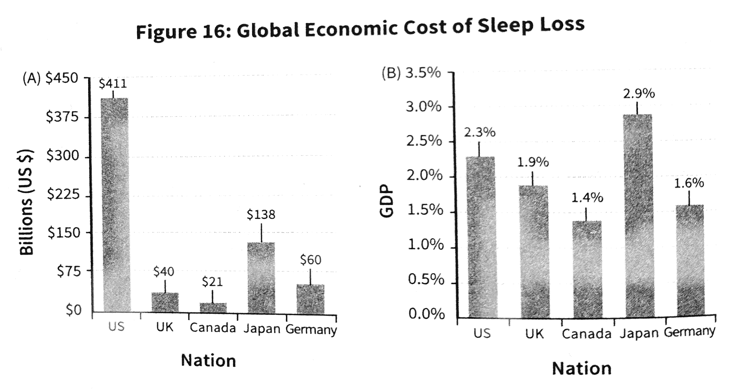
Education
- Teenagers in America routinely wakeup at 5:30am or earlier, to get to school.
- Delaying school start times by one hour leads to higher grades, increased life expectancy (due to less car crashes), and increased attendance.
- Adolescence is the most susceptible phase of life for developing chronic or mental illness.
- More than 50% of children with an ADHD diagnosis actually have a sleep disorder.
Healthcare
- The number of errors vastly increases when residents and doctors are deprived of sleep.
- Medics themselves are more likely to die in a traffic accident after a long shift.
- Before undergoing any serious surgery – ask your doctor how much sleep they have had.
- One cannot learn how to overcome a lack of sleep or develop resilience.
🎁 Chapter 16: a new vision for sleep in the twenty-first century
- Increase sleep awareness and teach it in schools.
- Incentivise employees to get better sleep.
- Offer flexibility in business hours and schools.
- Reward good sleep with lower health insurance costs.
- Link individual sleep trackers with connected devices, like thermostats and lighting.
